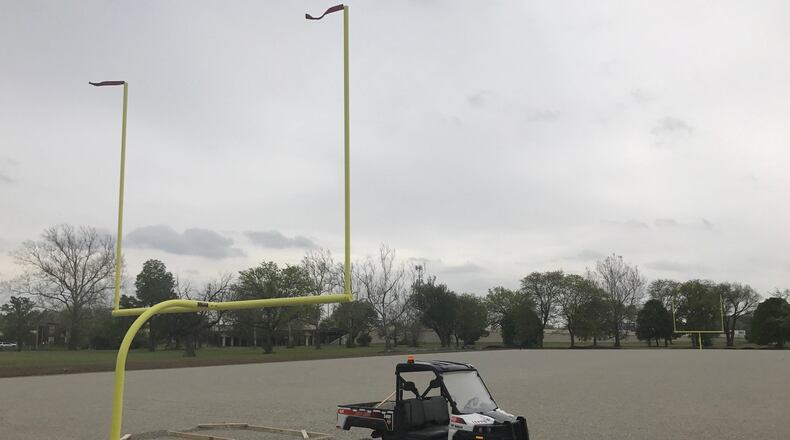The new field is being built at the site of the old Park Side Homes housing project off Keowee Street just north of the city core.
The gravel base of the field is completed, yellow goal posts have been erected at each end of the field and a 100-yard long concrete pad has been poured alongside the field to give spectators a place to congregate during games and practices.
Joe Parlette, Dayton’s deputy city manager, said all that’s left to do is install the field and enclose the facility in a fence.
Construction workers at the site Thursday afternoon said the field would be installed the week after Memorial Day.
“Obviously the field is going to be very popular once our society opens back up for outdoor sports,” Parlette said in reference to the COVID-19 pandemic which has curtailed all area sporting ventures for the past two months.
Parlette forsees the field being a big draw, especially for youth football teams, though it will be available to adult teams, schools and other groups. At the outset he said the field will just be lined off for football, but eventually could be configured for soccer, lacrosse and other sports.
“We’re all over the place in terms of opportunity,” Parlette said. “We’ve got our recreation staff doing some preliminary programming ideas. We anticipate training type opportunities for other sports, too.”
Originally the field was to be built at Triangle Park, near where the first game was played. But just before groundbreaking last May, a cultural heritage management firm using non-invasive ground penetrating radar tests discovered a unique and sizeable “abnormality” in the soil at a depth that predated the park and may have been prehistoric.
There was a real concern that this was the site of a Native American burial ground and the project was immediately halted.
Parlette said no effort was made to find out what the abnormality was:
“You don’t want to disturb the ground. In trying to find out what it is you could inadvertently destroy something.”
An alternative site was sought and the old Park Side expanse – which is just over 60 acres and was already part of a riverfront master plan for outdoor athletic use, Parlette said – became the focus.
The city – after dealing with Greater Dayton Premier Management, which, in turn, worked with HUD (United States Department of Housing and Urban Development) — got access to build the field and is in the process of getting ownership of the site, which is adjacent to Kettering Field.
Parlette said the city is paying for the cement pad and the fencing, which will insure proper access for those who sign up to use the field at reasonable rates.
The NFL Foundation – in conjunction with FieldTurf and Vesco - paid for construction and installation of the field.
“I don’t want to speak for the NFL, but in preliminary conversations a year ago they saw that Dayton didn’t have a field readily available for football for all aspects of the community,” Parlette said.
“This isn’t a case of the rich getting richer. Dayton didn’t have anything except Welcome Stadium, but that’s now owned by Dayton Public Schools. This will be available to the whole community.”
It was to ensure that and salute Dayton’s football history that the NFL became so involved.
A year ago the league set out to celebrate the 13 communities that were home to the 14 teams that were part of the inaugural 1920 season. At first the league was known as the American Professional Football Association, but soon after changed its name to the National Football League.
Credit: HANDOUT
Credit: HANDOUT
Dayton’s team was made up primarily of factory workers who earned up to $50 a week to put on leather helmets and wear a blue Triangles jersey. The team’s early stars included guys like Lou Partlow, “The West Carrollton Battering Ram, George “Hobby” Kinderdine, who played with a limp, Francis Bacon and Lee Fenner.
The Panhandles, who Dayton beat 14-0 in that first game, were made up of workers on the Pennsylvania Railroad.
The Triangles continued to play in Dayton until 1929 when a bootlegger bought them and moved them to Brooklyn.
In the decades that followed the memory of the team – and the contribution it had made to the league — faded into near obscurity, even though the Greater Dayton area has sent a steady stream of players – over three dozen – to the NFL.
It’s just in the past 15 to 20 years that recognition of and pride in the Triangles has steadily returned to this town.
And with it now comes this new field to nurture some of those same dreams local players had here a century ago.
Credit: DaytonDailyNews
About the Author

